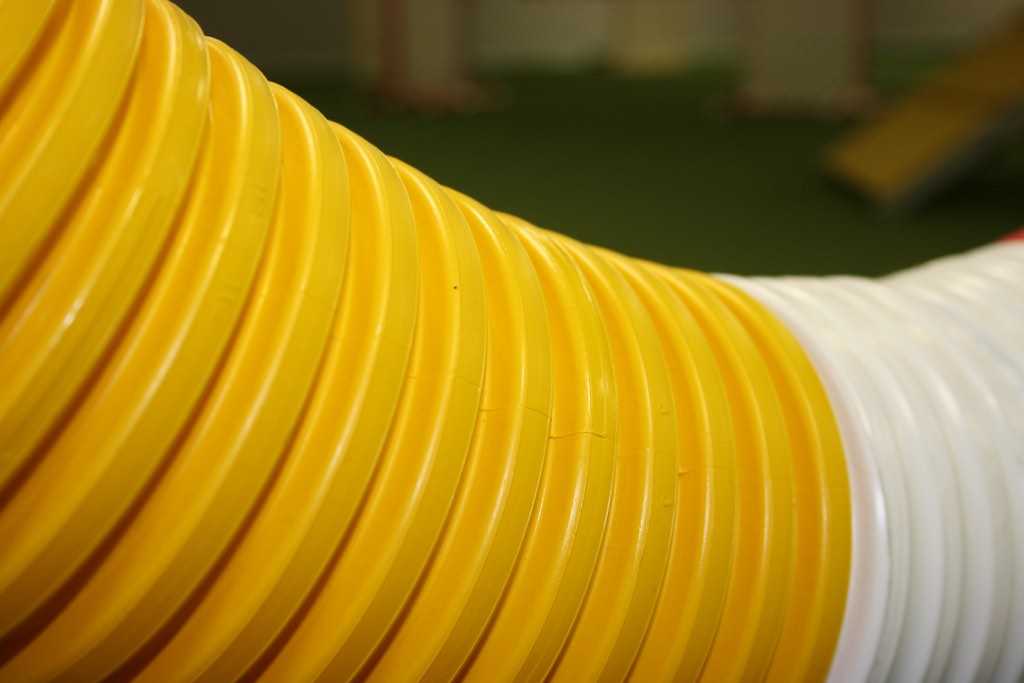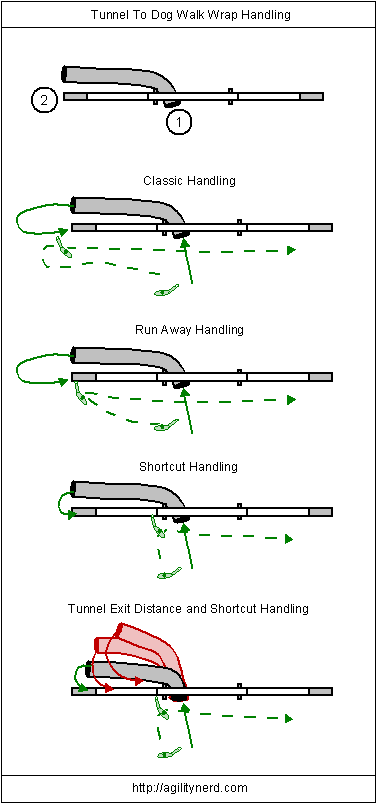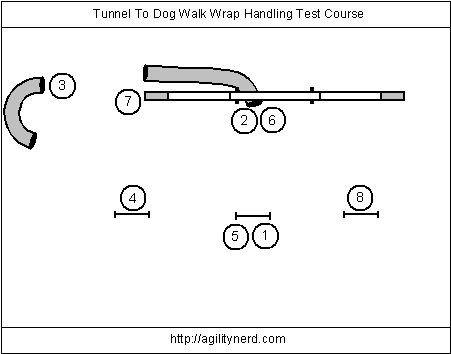Handling Tunnel to Dog Walk Wraps
16 Nov 2007
In the last year or so I’ve seen a slightly different method for handling tunnel to dog walk wraps that might of interest for some dog and handler teams. The first diagram in the figure below shows the setup I’m calling a tunnel to dog walk wrap. The dog goes from a tunnel directly up the dog walk with a sharp change of direction. I’ll first present two common handling methods and then present what I’m calling the “short cut” handling method and discuss it’s pros and cons.
The second diagram shows the “classic” handling method. Assuming the dog starts on the handler’s right on the entrance to the tunnel, the handler runs some distance of the way along the tunnel and until the dog exits the tunnel. The handler then Post Turns Learning the Post TurnPost Turn/Shoulder Pull/Pivot Turn in toward the dog (aka Counter Rotation) turning the dog sharply back toward the tunnel. The dog is now on the handler’s left. The dog has one or more strides on the flat to build speed before ascending the dog walk.
Another method, shown in the third diagram, is what I call the “run away” method. The handler goes to the start of the up plank. As soon as the dog appears at the exit of the tunnel the handler starts running down the dog walk.
The fourth diagram shows an alternate method for handling this same sequence. I haven’t heard anyone name this method yet, so I call it the “short cut” method. Once the dog has entered the tunnel the handler positions themselves on the ascending plank almost at the level portion of the dog walk and faces their body toward the exit of the dog walk. When the dog is about to exit the tunnel the handler calls the dog. Once the dog exits and turns toward the handler the handler begins moving down the dog walk. The dog turns tightly coming out of the tunnel directly onto the dog walk and ascends the dog walk.
Of course these methods can also be applied to tunnel to A frame wraps. But the steepness of the A Frame and its shorter length amplify the cons of the short cut handling method.
Pros and Cons of Short Cut Handling
The benefits of short cut handling include:
- The handler starts further ahead of the dog on the dog walk
- The dog can turn more tightly from the tunnel to the dog walk
- The dog's total time for this sequence may be faster
The potential difficulties of this handling include:
- The dog may miss the up contact on the dog walk and incur a fault
- In extreme cases the dog may not ascend the dog walk
- The dog's total time for this sequence may be slower
From the pros and cons you can see that this handling isn’t always “the right thing to do”. If you look at the final diagram in the figure you’ll see the black tunnel and green dog path show one situation where this handling is beneficial. The dog exits the tunnel and turns directly onto the yellow of the up contact; for a sharp and fast turn.
This diagram also shows in red situations where this handling isn’t so good. As the tunnel turns out away from the dog walk and/or shortens from the end of the dog walk the dog’s natural path moves further from putting them up the dog walk through the yellow. Calling the dog’s name (i.e. pulling on the Verbal Leash in these situations may also cause the dog to miss the up ramp as they come toward the handler. Furthermore the handler’s position (and motion if the handler starts moving down the dog walk) tend to pull the dog away from a correct dog walk entry. Of course you can train your dog to always seek out a straight approach to the dog walk even in these situations.
The handling is definitely course specific and especially dog specific. You must “Know Thy Dog”. From watching students and competitors it appears that small through medium sized dogs are able to perform this wrap so that it helps their dog walk performance. In general larger, heavier dogs, dogs that don’t turn tightly, novice dogs, or dogs that have trouble getting up to speed when starting the dog walk on the incline are not well suited for this handling method. As the tunnel moves back and away from the dog walk up ramp this handling becomes more difficult for dogs that don’t travel out far from the tunnel exit.
This is a handling strategy where your dog’s behavior will tell you more about its applicability than the stop watch. If your dog struggles to get up the dog walk or turns with difficulty it is definitely not the right thing for your dog. So let your dog tell you if this is right for them.
You could time the different handling approaches for the same setup to see if there is a difference. For fun I setup a little course that allowed me to take Meeker through the same tunnel with and without the wrap to the dog walk. That way he wouldn’t anticipate when we were going up the dog walk. On this sequence once you get to jump 8 you can start over with jump one repeat indefinitely.
I video taped and timed him from the tunnel exit to the end of the dog walk for a number of handling approaches. Meeker was one half second faster with the “short cut” handling than the “classic” handling. In the video I also moved the tunnel away and back from the dog walk up ramp so you could see how that affected his performance using these handling methods.
Originally I wasn’t that keen about the short cut handling approach. But after watching a couple dozen dogs in classes I will recommend it for those dog/handler teams for which it is not a problem for the dog. See how you and your dog feel about this handling and let me know your opinion.
If you enjoyed this article won't you please:  Thanks!
Thanks!


